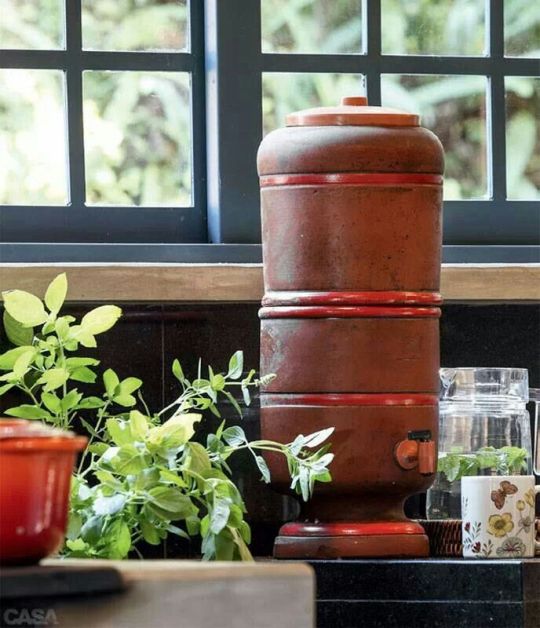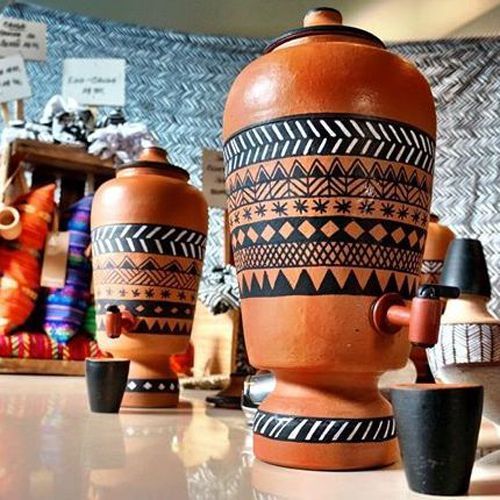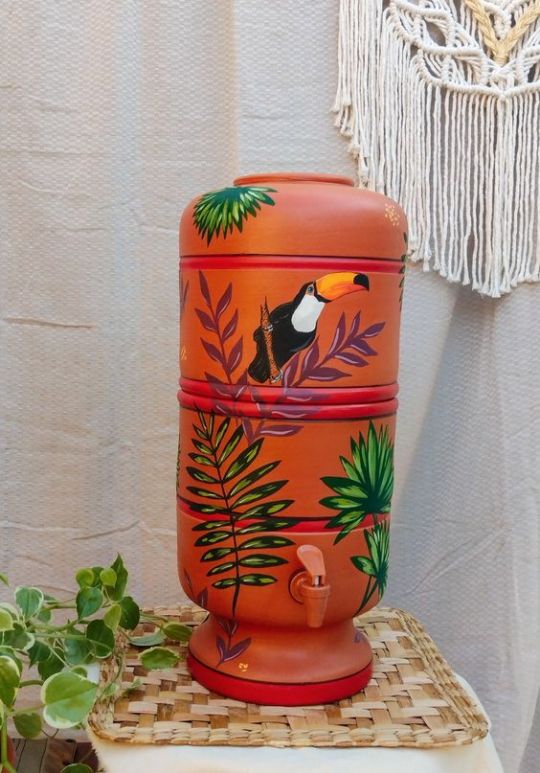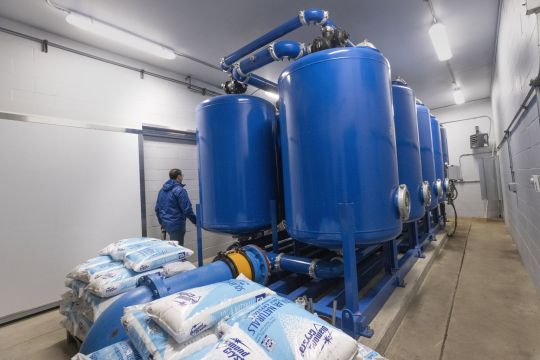#Water purification
Text













Water Purification Plant, Muttenz, Basel-Lanschaft, Switzerland,
Oppenheim Architecture Europe,
Photography Börje Müller
#art#design#architecture#minimal#nature#interiors#water#purification plant#sustainability#sustainable architecture#oppenheim architecture#switzerland#basel#muttenz#shotcrete#water purification
165 notes
·
View notes
Text
Solarpunk Aesthetic: Brazilian Clay Water Filters




I dithered a lot trying to decide on something to post about for Solarpunk Aesthetic Week, but at the end of the day I'm a Brazilian and I like to talk about Brazilian things... so here are some Brazilian Red Clay Water Filters! These are considered to this day one of the most reliable water purification systems in the world, and used to be very popular in the past all over Brazil before the rise of mineral water coolers in the 90s and early 2000s. The Red Clay keeps the water cool and they use a ceramic candle to filter water.
Nowadays, Red Clay filters live mostly in our memories of Brazil in the 80s or 90s (and in memes like "this represents Brazil more than Samba or caipirinha"), although there has been a bit of revival as design pieces, which is why these pictures are all decorated or integrated with planters. You can still find functional models like this for sale, however. But I believe Red Clay Water Filters belong in a concept of Brazilian Solarpunk for two reasons:
Although I couldn't find sources for the claim, it's widely believed here that this model was created in Brazil, with some speculation that the use of Red Clay and the characteristic shape of the filter originate from the use of red clay in ceramics by different indigenous cultures in Brazil (there is a type of water jug called moringa that evokes the idea of a red clay filter and has been around for centuries)
Brazil has a long history of water insecurity and poor sanitation all over the country, but personally I am more familiar with this issue in Northeast Brazil, where a combination of a challenging environment (especially in the sertão) and historical neglect by the government means the population in the rural areas was constantly facing intense droughts every dry season. In this context, I consider the existence of a reliable system of water filtration an essential aspect of Northeast Brazil's culture of resistance
This got a bit long, but I hope it made for an interesting read for anyone taking part in Solarpunk Aesthetic Week, or who just ended up here by chance. I mostly engage with Solarpunk through original fiction (still unpublished), but because of my introduction to it it's very hard to separate the aesthetic and movement from my own culture. Here's to continuing to imagine a future together!
449 notes
·
View notes
Text
instagram

#palestinian resilience#water crisis#palestine#gaza#basic human rights#human rights violations#i stand with palestine 🇵🇸#free gaza#free palestine 🇵🇸#free palestine#gaza strip#palestine resources#gazaunderattack#israel is committing genocide#Instagram#water purifier#water purification
15 notes
·
View notes
Link
Access to clean water is being strained as the human population increases and contamination impacts freshwater sources. Devices currently in development that clean up dirty water using sunlight can only produce up to a few gallons of water each day. But now, researchers in ACS Central Science report how loofah sponges inspired a sunlight-powered porous hydrogel that could potentially purify enough water to satisfy someone's daily needs—even when it's cloudy.
Previously, researchers have suggested that sunlight-driven evaporation could be a low-energy way to purify water, but this approach doesn't work well when it's cloudy. One solution could be temperature-responsive hydrogels, specifically poly(N-isopropyl acrylamide) (PNIPAm), that switch from absorbing water at cooler temperatures to repelling it when heated. However, conventional PNIPAm gels can't generate clean water fast enough to meet people's daily needs because of their closed-off pores. Conversely, natural loofahs, which many people use to exfoliate in the shower, have large, open and interconnected pores. So, Rodney Priestley, Xiaohui Xu, and colleagues wanted to replicate the loofah's structure in a PNIPAm-based hydrogel, yielding a material that could rapidly absorb water at room temperature, and rapidly release purified water when heated by the sun's rays under bright or cloudy conditions.
Continue Reading
116 notes
·
View notes
Text
Primitive life straw.
#survival#water purification#outdoors#yearzerosurvival.com#preppers#survival blog#preppertalk#prepper blog#prepper#shtf#prepper network#camping#yearzerosurvival#year zero survival#survival forum#survival preppers#hiking#off the grid#bugout#bug out
11 notes
·
View notes
Text
aquaquot is a WATER PURIFIER related SERVICES provider in Bangalore.
water purifier on lease, water purifier repairs, water purifier services, buy water purifier and accessories at affordable price.
2 notes
·
View notes
Photo


More ‘forever chemicals’ found in WA drinking water as cleanup costs mount
Dec. 11, 2022 Seattle Times (paywall)
570,000 people, 7.4% of the state’s population, according to a Seattle Times analysis of test results
LAKEWOOD, Pierce County — The water pumped from the ground here was once considered pure enough to mix with a little chlorine and then pipe directly to homes.
Today, every gallon from two water district wells must first be flushed through six enormous tanks, each filled with 40,000 pounds of specially treated coal, to remove contaminants.
This pollution, known as “forever chemicals” or PFAS, can increase health risks for certain cancers and other diseases when present in drinking water in minuscule concentrations measured in parts per trillion. Lakewood is one of more than a dozen Washington public water systems with detections above levels defined by the state to be suitable for long-term consumption — and widespread testing is just ramping up.
a massive legal battle is playing out across the country as more than 200 providers of public drinking water, including Lakewood, sue manufacturers, distributors and in some cases the Defense Department in federal court to determine who will pay the cleanup bills that will tally in the billions of dollars.
In December 1988, 3M chemist Eric Reiner wrote a memo to his colleagues about the corporation’s firefighting foams formulated with PFAS.
For years, the corporation’s marketing pitch portrayed them as “biodegradable.” Reiner termed this a “myth” that was not in 3M’s long-term term interest to perpetuate.
“It is probable that this misconception will eventually be discovered, and when that happens, 3M will likely be embarrassed, and we and our customers may be fined and forced to immediately withdraw products from the market,” Reiner warned.
3M no longer produces the foams that contained PFOA and PFOS. Reiner’s memo is one of many internal 3M documents put into the public record in the avalanche of litigation now consolidated in the U.S. District Court of South Carolina.
3M and other manufacturers initially sought to have many lawsuits dismissed based on case law that has sometimes granted immunity from liability to contractors supplying products requested by the U.S. military.
In a Sept. 16 opinion, U.S. District Court Judge Richard Mark Gergel of South Carolina found 3M and other defendants “knowingly withheld” information detailing the full risks of the product and denied that motion.
#washington state#public water system#PFAS#forever chemicals#3M#water contamination#water purification#2022
10 notes
·
View notes
Text
Choosing the Right Survival Prepping Option: A Guide to Find Your Best Fit
In uncertain times, being prepared for emergencies is crucial. But with numerous survival prepping options available, finding the right one for you can be overwhelming. Fear not, as this comprehensive guide is here to help. Whether you're a city dweller or a wilderness enthusiast, this resource will navigate you through various prepping options, from bug-out bags to homesteading, self-sufficiency to tactical prepping. Discover the essentials of food storage, water purification, emergency shelter, and first aid. Uncover the secrets of outdoor survival and wilderness skills. Explore the realms of self-defense, alternative energy, and crisis management. Equip yourself with the knowledge to make informed decisions and ensure your readiness for any situation.
#Survival Prepping#Prepping Options#Emergency Preparedness#Survival Skills#Bug Out Bag#Homesteading#Self Sufficiency#Food Storage#Water Purification#Emergency Shelter#First Aid#Outdoor Survival#Wilderness Skills#Tactical Prepping#Urban Survival#Natural Disaster Preparedness#Self Defense#Community Preparedness#Alternative Energy#Crisis Management
6 notes
·
View notes
Text
best tap water filters that filter fluoride:
please drop links!
#fluoride#healthy#health#healthyfood#healthy drinks#healthy food#healthy fitness#neurotoxin#healthy mind#healthy morning drinks#water purifier service#water timely reminder#water purification#water purifier online#water pump#drinkingwater#drink water#organic
5 notes
·
View notes
Text
Essential Survival Tips for Outdoor Enthusiasts
Did you know that nearly 90% of wilderness survival situations come from human mistakes or not being ready? This fact shows how key it is to be prepared for unexpected challenges outdoors. As someone who loves the outdoors, I know that learning survival skills is crucial for staying safe and strong in the wild.
Skills like building shelters, starting fires, and purifying water are essential. They…
#Camping Essentials#Emergency Preparedness#Fire starting techniques#First aid in the wild#Navigation skills#Outdoor safety#Shelter building#Survival kit essentials#Water Purification#Wilderness Survival
0 notes
Text
Point-Of-Use Water Treatment System Market - Forecast(2024 - 2030)
Point-of-Use Water Treatment Systems Market Overview:
Point-of-Use Water Treatment Systems are becoming exceedingly common across various application facilities particularly in homes, schools, residential and non-residential facilities. The main goal of such systems are for the treatment of smaller, continuous supply of water for consumption. This market is segmented based on its technology, design, applicable standards and end users.
Point-of-Use Water Treatment Systems Market Outlook:
According to an IndustryArc report, Point-of-Use Water Treatment Systems market was valuated at $9.5 billion in 2015 and is expected to reach $15.6 billion by 2022. Water purification has become the need of the hour as UN records more than 4 billion cases of diarrhea every year due with the major cause being water contamination. Health institutes, public organizations, governments and NGOs have been aggressive in promoting many of these water treatment systems particularly in the developing countries where access to safe drinking water is limited or scarce.
Request Sample
Point-of-Use Water Treatment Systems Market Growth drivers:
One of the major growth contributors to the Point-of-Use Water Treatment Systems market is the growing human population especially in the developing countries with a current population of 7.6 billion. It is expected to rise to 8.6 billion in 2030. This exponential growth will surely trigger a rise in demand for Point-of-Use Water Treatment Systems as natural resources such as clean water become scarcer.
Innovative, sustainable and energy efficient water treatment technologies are being innovated almost daily due to the immensely high demand for safe and pure drinking water. Nanotechnology based solutions, UV and UF treatment combinations, organic and biodegradable filtering solutions are some of the key innovations been developed. Furthermore, the lack of access to safe drinking water is a global issue that affects all humanity and thus this triggered a global participation in developing newer treatment technologies that is affordable to the common man especially in the developing countries.
Point-of-Use Water Treatment Systems Market Challenges:
The prime challenge faced by the Point-of-Use Water Treatment Systems market is the varying quality of water available across a wide geographical area. The chemical and physical properties of water differ from place to place, such as heavy metal contamination, hard and soft water, etc. This means key players need to design either universal water treatment solution or particular treatment solutions targeting particular geographical areas.
Another major challenge to the Point-of-Use Water Treatment Systems market is the wide penetration of purified water bottle companies that also serve to solve the problem of unsustainable and toxic drinking water. Places like Flint, Michigan, USA has an aggravated problem of lead contamination in drinking water. Thus, bottled water seem to be the safer option compared to Point-of-Use Water Treatment Systems as perceived by the affected citizens. During the Flint water crisis, many residents claimed that they do not trust filter systems but only choose to use bottled water. Thus the trust level in these Point-of-Use Water Treatment Systems were at an all-time low, especially when it was the right time, for an increase in demand for such systems.
Inquiry Before Buying
Point-of-Use Water Treatment Systems Market Research Scope:
The base year of the study is 2017, with forecast done up to 2023. The study presents a thorough analysis of the competitive landscape, taking into account the market shares of the leading companies. It also provides information on unit shipments. These provide the key market participants with the necessary business intelligence and help them understand the future of the Point-of-Use Water Treatment Systems market. The assessment includes the forecast, an overview of the competitive structure, the market shares of the competitors, as well as the market trends, market demands, market drivers, market challenges, and product analysis. The market drivers and restraints have been assessed to fathom their impact over the forecast period. This report further identifies the key opportunities for growth while also detailing the key challenges and possible threats. The key areas of focus include the types of plastics in the Point-of-Use Water Treatment Systems market, and their specific applications in different types of vehicles.
Point-of-Use Water Treatment Systems Market Report: Industry Coverage
Point-of-Use Water Treatment Systems– By Technology: Filtration Methods, Reverse Osmosis Systems, Distillation Systems, etc
Point-of-Use Water Treatment Systems– By Design: Personal water bottle with filter, Pour through filter with pitcher, Faucet Mounted Filter with diverter, etc
Point-of-Use Water Treatment Systems– By Applicable Standards: NSF International, ANSI (American National Standards Institute), US EPA (Environmental Protection Agency), JWPA (Japan Water Purifier Association), etc
Point-of-Use Water Treatment Systems– By End User: Residential and Non-Residential
Schedule a Call
The Point-of-Use Water Treatment Systems market report also analyzes the major geographic regions for the market as well as the major countries for the market in these regions. The regions and countries covered in the study include:
North America: The U.S., Canada, Mexico
South America: Brazil, Venezuela, Argentina, Ecuador, Peru, Colombia, Costa Rica
Europe: The U.K., Germany, Italy, France, The Netherlands, Belgium, Spain, Denmark
APAC: China, Japan, Australia, South Korea, India, Taiwan, Malaysia, Hong Kong
Middle East and Africa: Israel, South Africa, Saudi Arabia
Point-of-Use Water Treatment Systems Market Key Players Perspective:
Some of the Key players in this market that have been studied for this report include: CP Kelco Oil Field Group, Huntsman Corporation, Croda International PLC, Weatherford International, Stepan Company, Enviro Fluid, Rimpro-India, Evonik Industries AG, Flotek Industries and others
Buy Now
Market Research and Market Trends of Point-of-Use Water Treatment Systems Market
Researchers at the Yale University have developed a nanocoagulant material for the treatment of water contaminants. This new nanotechnology based water treatment system was inspired by the sea organism named, Actinia that captures its prey using its tentacles. This treatment method is highly novel, as it significantly removes contaminants in a single coagulative action, without the need for multiple treatment processes. Creating an efficient and easy-to-operate technology to remove all contaminants from water is key to addressing global water scarcity.
Based on World Health Organization, there are an estimated 1.7 billion cases of childhood diarrhoeal disease every year as a result of lack of safe drinking water and sanitation. Researchers in India have recently come up with a solution to this problem with a water treatment system using nanotechnology. This water treatment technology uses composite nanoparticles that emit silver ions which result in destroying contaminants. The researchers claim that this kind of water treatment systems using nanotechnology, will have a vital role in the future water treatment system market.
Havells India recently entered the Point-of-Use Water Treatment Systems market, with one of its key products named Havells Max 100% RO & UV. This new product claims to include 7 purification segments including UV and RO treatment processes. As new players enter the water purification market segment in developing countries like India confirms the theory that increasing urbanization pan India, would lead to an increase in demand for Point-of-Use Water Treatment Systems in the future.
Fairey Industrial Ceramics Limited trading as Doulton Water Filters.
#point-of-use water treatment system market#point-of-use water treatment system market price#point-of-use water treatment system market report#point-of-use water treatment system market research#point-of-use water treatment system market size#point-of-use water treatment system market forecast#point-of-use water treatment system market analysis#Water purification
0 notes
Text
The Importance of Commercial Water Purifiers: A Guide to Clean Water Solutions for Businesses
Water is the backbone of every business, and ensuring its purity is essential for industries ranging from food and beverage to pharmaceuticals. In today’s world, where water contamination is a growing concern, having a reliable commercial water purifier is no longer optional—it’s a necessity.
Why Commercial RO Water Purifiers Matter
Commercial RO (Reverse Osmosis) water purifiers offer a robust solution for businesses needing to maintain high water quality standards. By removing harmful contaminants, dissolved salts, and chemicals, these systems provide clean, safe water critical for industrial processes. This ensures compliance with regulatory standards like HACCP, cGMP, and FSSAI, particularly in industries where water quality directly impacts product safety.
Industries that Benefit from RO Systems
Food & Beverage: Ensures product quality and customer safety by providing clean water for production and processing.
Pharmaceuticals: Guarantees the purity of water used in drug manufacturing, a critical factor for compliance.
Healthcare: Delivers safe, contaminant-free water for hospital and clinical use.
Choosing the Right Water Purification System
When selecting a commercial water purifier, businesses should consider capacity, water quality needs, and maintenance requirements. If you're in search of a solution that ensures consistent water quality, Alfaa UV’s commercial RO water purifiers are designed to meet the demands of any industry.
For more information on how our Commercial RO Water Purifiers can enhance your business operations, visit our website today.
#water purifier#water purification#ro water purifier#health & fitness#uv water purifier#water purifiers#pure water#drinking water
0 notes
Text
Health Risks of Contaminated Water: How Manufacturers Prevent Them
Water is fundamental to life, but when contaminated, it can pose serious health risks. From gastrointestinal diseases to long-term chronic illnesses, polluted water can wreak havoc on our health.

In this article, we’ll explore the dangers of contaminated water and how manufacturers work tirelessly to ensure the water we drink is clean and safe.
Health Risks of Contaminated Water
1. Gastrointestinal Diseases:
Contaminated water often contains harmful microorganisms such as bacteria, viruses, and parasites. These pathogens can lead to diseases like diarrhea, cholera, dysentery, and typhoid fever. Symptoms include vomiting, dehydration, and abdominal cramps. Children and the elderly are especially vulnerable to these waterborne diseases.
2. Chemical Contaminants:
Water can be tainted with chemicals like lead, arsenic, and pesticides. Long-term exposure to these toxins can result in cancer, liver and kidney damage, and reproductive issues. These pollutants often come from industrial waste, agricultural runoff, or old plumbing systems.
3. Heavy Metals:
Heavy metals like lead and mercury are particularly dangerous, especially to children. Lead exposure can lead to developmental delays, while mercury affects the nervous system and cognitive function.
4. Emerging Contaminants:
Recently, pharmaceuticals, personal care products, and endocrine-disrupting compounds have been detected in water sources. These emerging contaminants can have unpredictable effects on human health and ecosystems, making water safety an ever-evolving challenge.
How Manufacturers Prevent Water Contamination
1. Source Protection:
Water manufacturers protect the source of the water they use, often drawing it from deep wells or protected reservoirs. Regular assessments are conducted to ensure the source remains uncontaminated.
2. Advanced Filtration Technologies:
Leading water manufacturers, like Priti International in Kolkata, use cutting-edge purification methods, including:
Reverse Osmosis (RO): This process filters out dissolved salts, bacteria, viruses, and other impurities.
Ultraviolet (UV) Treatment: UV light is used to disinfect water, killing harmful microorganisms.
Activated Carbon Filtration: This method helps remove organic contaminants, chlorine, and other chemicals.
3. Rigorous Testing and Quality Control:
Manufacturers perform regular water tests to ensure it meets safety standards. These tests screen for microbial, chemical, and physical contaminants. Strict quality control measures ensure that the water remains safe throughout the production process.
4. Sanitation and Hygiene Practices:
Proper sanitation practices are essential to prevent contamination during bottling. Equipment is regularly cleaned, and employees follow strict hygiene protocols to avoid introducing pollutants.
5. Food-Grade Materials:
Bottled water containers are made from food-grade materials to prevent chemical leaching. This ensures that no harmful substances seep into the water, even during long storage periods.
6. Compliance with Regulations:
Manufacturers must meet stringent local and international water quality standards set by agencies like the FDA and EPA. This ensures that the water produced is safe for public consumption.
7. Consumer Education:
Manufacturers often engage in educating consumers about safe water handling and storage. This helps individuals recognize potential signs of contamination and take appropriate steps to ensure the water they consume remains clean.
Conclusion
Contaminated water poses significant health risks, but water manufacturers play a key role in safeguarding public health. By protecting water sources, employing advanced purification technologies, conducting rigorous testing, and complying with strict regulations, manufacturers like Priti International ensure the water we drink is safe.
As consumers, it’s important to understand these processes to make informed decisions about the water we consume. By doing so, we can reduce health risks and trust that manufacturers are doing their part to provide clean, safe drinking water.
If you’re looking for a reliable water treatment solution, connect with Priti International, the leading water treatment plant manufacturer in Kolkata.
0 notes
Text

Designed for whole-home water conditioning, it removes impurities and softens water, giving you healthier water for drinking, cooking, and bathing. https://www.kentwater.ca/
#best water filtration system for home#household water filtration system#Water Filtration#Water Purification
0 notes
Text
500 Billion Liters and Counting: Why Pharma Needs Sustainable Water Purification

Pharmaceutical companies use approximately 500 billion liters of water every year. While traditional water purification methods contribute to a substantial carbon footprint, sustainable water purification systems are redefining the game by minimizing energy use, reducing chemical waste, and focusing on renewable resources.
As the world becomes increasingly aware of environmental issues, the pharmaceutical industry faces growing pressure to adopt sustainable practices. Many companies are now integrating eco-friendly water purification solutions to actively work toward their sustainability goals.
Key Features of Sustainable Water Purification Systems
1. Energy Efficiency
Sustainable water purification systems consume far less energy compared to traditional methods. Opting for systems powered by renewable energy, like solar panels, further reduces energy consumption and promotes eco-friendly practices.
2. Minimal Use of Chemicals
These systems prioritize reducing harmful chemicals in water treatment. For example, they use ethylenediamine-N, N’-disuccinic acid (EDDS), a biodegradable agent that binds and removes heavy metals, unlike traditional agents that are less environmentally friendly. Another innovative approach is using peracetic acid (PAA), an organic compound that breaks down into harmless substances, providing an effective and green alternative to chlorine.
3. Reduced Waste Generation
Technologies like Zero-Liquid Discharge (ZLD) systems ensure no waste is left behind by treating and reusing all water. ZLD can help cut water waste by up to 90%, offering a sustainable solution that benefits both the environment and the bottom line.
4. Use of Renewable Resources
Switching to renewable energy sources like solar and wind power can significantly reduce a company’s carbon footprint. For instance, a solar installation can offset CO₂ emissions equivalent to the work of 1,600 trees over ten years. Wind-powered systems can also save up to 30% of energy, making them an ideal choice for sustainable water management.
Innovative Technologies in Sustainable Water Purification
1. Advanced Membrane Filtration
Nanofiltration (NF) and Ultrafiltration (UF) can remove up to 99.9% of contaminants, including bacteria and viruses, while consuming significantly less energy than reverse osmosis. Forward Osmosis (FO) saves up to 30% more energy and achieves high water recovery rates, further reducing environmental impact.
2. Electrodeionization (EDI)
EDI systems produce ultra-pure water without the need for harsh chemical treatments. This technology reduces chemical waste by up to 90% and meets the stringent water quality requirements of the pharmaceutical industry.
3. Ultraviolet (UV) Disinfection
UV systems offer a non-chemical method to achieve up to a 99.99% disinfection rate. UV disinfection minimizes harmful by-products, making it an effective and environmentally friendly solution for water treatment.
4. Ozonation
Ozone is a powerful oxidant that eliminates up to 99% of organic contaminants without leaving harmful residues. This method is ideal for reducing total organic carbon (TOC) levels by up to 70%.
5. Zero Liquid Discharge (ZLD) Systems
ZLD technology recovers up to 95% of wastewater, significantly reducing the need for fresh water and cutting water consumption by up to 60% in the pharmaceutical sector.
The Path Forward: Overcoming Challenges
While sustainable water purification offers numerous benefits, there are challenges to adoption, including the initial costs, ongoing maintenance, and the need for specialized technical expertise. However, with tax incentives, grants, and subsidies available, the transition becomes more feasible.
At TSA, we provide cost-effective, sustainable water purification systems tailored to your needs. Our high-purity water treatment solutions use advanced technologies like electrodeionization and closed-loop recirculation, helping you meet the highest standards while safeguarding the environment.
Get in Touch
Ready to explore sustainable solutions? Contact TSA today to craft a water management plan that aligns with your environmental and business goals.
#waterpurifier#purified water#water purifier#water purification#water purification system#purified water system
0 notes
Text

Saving Lives: Learn How to Obtain Drinkable Water in an Emergency Situation
#survival#outdoors#yearzerosurvival.com#preppers#survival blog#preppertalk#prepper blog#prepper#shtf#prepper network#camping#yearzerosurvival#year zero survival#survival forum#survival preppers#off the grid#bugout#water purification#water
17 notes
·
View notes